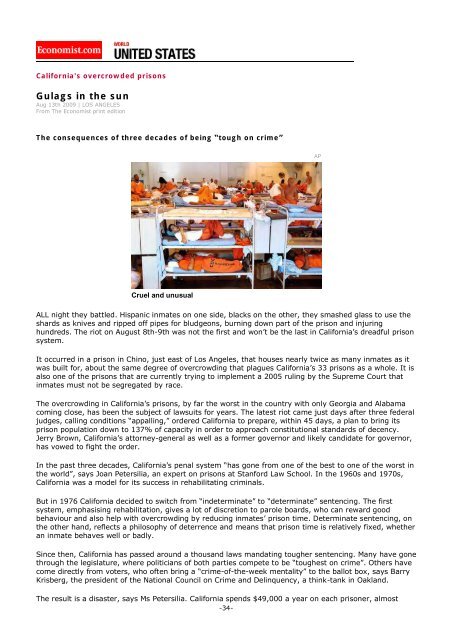Untitled - the ultimate blog
Untitled - the ultimate blog
Untitled - the ultimate blog
You also want an ePaper? Increase the reach of your titles
YUMPU automatically turns print PDFs into web optimized ePapers that Google loves.
California's overcrowded prisons<br />
Gulags in <strong>the</strong> sun<br />
Aug 13th 2009 | LOS ANGELES<br />
From The Economist print edition<br />
The consequences of three decades of being “tough on crime”<br />
AP<br />
Cruel and unusual<br />
ALL night <strong>the</strong>y battled. Hispanic inmates on one side, blacks on <strong>the</strong> o<strong>the</strong>r, <strong>the</strong>y smashed glass to use <strong>the</strong><br />
shards as knives and ripped off pipes for bludgeons, burning down part of <strong>the</strong> prison and injuring<br />
hundreds. The riot on August 8th-9th was not <strong>the</strong> first and won’t be <strong>the</strong> last in California’s dreadful prison<br />
system.<br />
It occurred in a prison in Chino, just east of Los Angeles, that houses nearly twice as many inmates as it<br />
was built for, about <strong>the</strong> same degree of overcrowding that plagues California’s 33 prisons as a whole. It is<br />
also one of <strong>the</strong> prisons that are currently trying to implement a 2005 ruling by <strong>the</strong> Supreme Court that<br />
inmates must not be segregated by race.<br />
The overcrowding in California’s prisons, by far <strong>the</strong> worst in <strong>the</strong> country with only Georgia and Alabama<br />
coming close, has been <strong>the</strong> subject of lawsuits for years. The latest riot came just days after three federal<br />
judges, calling conditions “appalling,” ordered California to prepare, within 45 days, a plan to bring its<br />
prison population down to 137% of capacity in order to approach constitutional standards of decency.<br />
Jerry Brown, California’s attorney-general as well as a former governor and likely candidate for governor,<br />
has vowed to fight <strong>the</strong> order.<br />
In <strong>the</strong> past three decades, California’s penal system “has gone from one of <strong>the</strong> best to one of <strong>the</strong> worst in<br />
<strong>the</strong> world”, says Joan Petersilia, an expert on prisons at Stanford Law School. In <strong>the</strong> 1960s and 1970s,<br />
California was a model for its success in rehabilitating criminals.<br />
But in 1976 California decided to switch from “indeterminate” to “determinate” sentencing. The first<br />
system, emphasising rehabilitation, gives a lot of discretion to parole boards, who can reward good<br />
behaviour and also help with overcrowding by reducing inmates’ prison time. Determinate sentencing, on<br />
<strong>the</strong> o<strong>the</strong>r hand, reflects a philosophy of deterrence and means that prison time is relatively fixed, whe<strong>the</strong>r<br />
an inmate behaves well or badly.<br />
Since <strong>the</strong>n, California has passed around a thousand laws mandating tougher sentencing. Many have gone<br />
through <strong>the</strong> legislature, where politicians of both parties compete to be “toughest on crime”. O<strong>the</strong>rs have<br />
come directly from voters, who often bring a “crime-of-<strong>the</strong>-week mentality” to <strong>the</strong> ballot box, says Barry<br />
Krisberg, <strong>the</strong> president of <strong>the</strong> National Council on Crime and Delinquency, a think-tank in Oakland.<br />
The result is a disaster, says Ms Petersilia. California spends $49,000 a year on each prisoner, almost<br />
-34-








![[ccebbook.cn]The Economist August 1st 2009 - the ultimate blog](https://img.yumpu.com/28183607/1/190x252/ccebbookcnthe-economist-august-1st-2009-the-ultimate-blog.jpg?quality=85)



![[ccebook.cn]The World in 2010](https://img.yumpu.com/12057568/1/190x249/ccebookcnthe-world-in-2010.jpg?quality=85)
![[ccemagz.com]The Economist October 24th 2009 - the ultimate blog](https://img.yumpu.com/5191885/1/190x252/ccemagzcomthe-economist-october-24th-2009-the-ultimate-blog.jpg?quality=85)